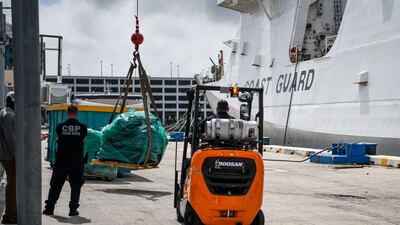A US Coast Guard vessel on Thursday offloaded more than 30 tonnes of cocaine and marijuana reportedly worth more than $1 billion, which was seized at sea during a months-long operation off the coast of South America.
The haul of illegal narcotics taken home by the US Coast Guard cutter James was one of the biggest in recent memory, using sophisticated equipment that includes powerful drones and infrared cameras that can detect heat from small cocaine-filled vessels.
But it also highlights a recent surge in narcotics coming from Colombia, a close US ally and the world’s top producer of cocaine.
The Biden administration’s top anti-narcotics officials travelled to South Florida to welcome back the ship's crew and promote the Coast Guard’s role in intercepting drugs before they reach American streets.
“We are hitting the drug traffickers where it hits them most: their pocketbooks,” said Dr Rahul Gupta, head of the White House’s Office of National Drug Control Policy.
Dr Gupta said the Biden administration was seeking to increase the US government’s budget to build up the nation’s addiction treatment and reduce the supply of synthetic opioids including fentanyl, and other drugs.
But the record seizures of late by the Coast Guard, federal law enforcement and partner nations also underscores how little the flow of cocaine coming from Latin America has eased since president Richard Nixon declared war on drugs a half century ago.
Coca cultivation in Colombia in 2020 soared to 245,000 hectares, enough to produce 1,010 tonnes of cocaine, according to the White House’s latest report on harvesting trends in the Andean region.
As recently as 2014, potential production was less than half that amount. Production in Peru and Bolivia has also steadily risen.
Admiral Karl Schultz, the US Coast Guard commander, said those numbers would be even higher, and the destabilising effect on the region from transnational criminal organisations greater, if not for the US interception efforts.
“Does it matter? It absolutely matters because it kind of keeps a lid on things,” Admiral Schulz said.
His comments were echoed by Ambassador Todd Robinson, who leads the State Department’s bureau of International Narcotics and Law Enforcement Affairs.
“It’s not just always about seizures,” said Mr Robinson, who had served as the US’s top diplomat in Guatemala and Venezuela, two major transit zones for Colombian cocaine.
“It’s also about building our partners’ capacity.”
How to wear a kandura
Dos
- Wear the right fabric for the right season and occasion
- Always ask for the dress code if you don’t know
- Wear a white kandura, white ghutra / shemagh (headwear) and black shoes for work
- Wear 100 per cent cotton under the kandura as most fabrics are polyester
Don’ts
- Wear hamdania for work, always wear a ghutra and agal
- Buy a kandura only based on how it feels; ask questions about the fabric and understand what you are buying
Our legal consultant
Name: Dr Hassan Mohsen Elhais
Position: legal consultant with Al Rowaad Advocates and Legal Consultants.
Key facilities
- Olympic-size swimming pool with a split bulkhead for multi-use configurations, including water polo and 50m/25m training lanes
- Premier League-standard football pitch
- 400m Olympic running track
- NBA-spec basketball court with auditorium
- 600-seat auditorium
- Spaces for historical and cultural exploration
- An elevated football field that doubles as a helipad
- Specialist robotics and science laboratories
- AR and VR-enabled learning centres
- Disruption Lab and Research Centre for developing entrepreneurial skills
The President's Cake
Director: Hasan Hadi
Starring: Baneen Ahmad Nayyef, Waheed Thabet Khreibat, Sajad Mohamad Qasem
Rating: 4/5
UAE currency: the story behind the money in your pockets
The White Lotus: Season three
Creator: Mike White
Starring: Walton Goggins, Jason Isaacs, Natasha Rothwell
Rating: 4.5/5
MATCH INFO
Tottenham Hotspur 1
Kane (50')
Newcastle United 0
More on animal trafficking
MEDIEVIL%20(1998)
%3Cp%3E%3Cstrong%3EDeveloper%3A%3C%2Fstrong%3E%20SCE%20Studio%20Cambridge%3Cbr%3E%3Cstrong%3EPublisher%3A%3C%2Fstrong%3E%20Sony%20Computer%20Entertainment%3Cbr%3E%3Cstrong%3EConsole%3A%3C%2Fstrong%3E%20PlayStation%2C%20PlayStation%204%20and%205%3Cbr%3E%3Cstrong%3ERating%3A%3C%2Fstrong%3E%203.5%2F5%3C%2Fp%3E%0A
Timeline
2012-2015
The company offers payments/bribes to win key contracts in the Middle East
May 2017
The UK SFO officially opens investigation into Petrofac’s use of agents, corruption, and potential bribery to secure contracts
September 2021
Petrofac pleads guilty to seven counts of failing to prevent bribery under the UK Bribery Act
October 2021
Court fines Petrofac £77 million for bribery. Former executive receives a two-year suspended sentence
December 2024
Petrofac enters into comprehensive restructuring to strengthen the financial position of the group
May 2025
The High Court of England and Wales approves the company’s restructuring plan
July 2025
The Court of Appeal issues a judgment challenging parts of the restructuring plan
August 2025
Petrofac issues a business update to execute the restructuring and confirms it will appeal the Court of Appeal decision
October 2025
Petrofac loses a major TenneT offshore wind contract worth €13 billion. Holding company files for administration in the UK. Petrofac delisted from the London Stock Exchange
November 2025
180 Petrofac employees laid off in the UAE








